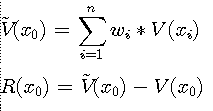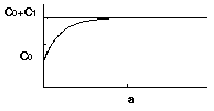GOAL
The goal of this project is to implement an ordinary kriging module for IBM Data Explorer 2.0 using C language. This module takes a number of input data, including a field of observed data, the estimated range, the resolution of the estimated range, variogram model, nugget effect and sill. The output is a field of estimated value and error variance.THEORY
In ordinary kriging, which estimates the unknown value using a weighted linear combinations of the available sample[2]:
 (1)
(1)
The error of i-th estimate, ri, is the difference of estimated value and true value at that same location:
 (2)
(2)
The average error of a set of k estimates is:
 (3)
(3)
The error variance is:
 (4)
(4)
Unfortunately, we can not use the equation because we do not know the true value V1,...,Vk. In order to solve this problem, we apply a stationary random function that consists of several random variables, V(Xi). Xi is the location of observed data for i > 0 and i <= n. ( n is the total number of observed data). The unknown value at the location X0 we are trying to estimate is V(X0). The estimated value represented by random function is:
 (5)
(5)
The error variance is :
 (6)
(6)
 is the covariance of the random variable V(X0) with
itself and we assume that all of our random variables have the same variance.
is the covariance of the random variable V(X0) with
itself and we assume that all of our random variables have the same variance.
 is the Lagrange parameter[2].
is the Lagrange parameter[2].
In order to get the minimum variance of error, we calculate the partial first derivatives of the equation (6) for each w and setting the result to 0. Here is the example of differentiation with respect to w1:
 (7)
(7)
All of weight Wi can be represented as:
 For each i, 1 <= i <= n (8)
For each i, 1 <= i <= n (8)
We can get the each weight Wi through the equation (8). After getting the value,
we can estimate the value located in X0.
The minimized estimation variance is:
The kriging module includes two variogram models:
1. spherical
2. exponential
Nugget effect (c0) :
Though the value of the variogram for h = 0 is strictly 0,
several factors, such as sampling error and short scale variability, may cause
sample values separated by extremely small distances to be quite dissimilar.
This causes a discontinuity at the origin of the variogram. The vertical jump
from the value of 0 at the origin to the value of the variogram at extremely
small separation distances is called the nugget effect.[2]
Range (a) :
The distance of two pairs increase, the variogram of those two pairs
also increase. Eventually, the increase of the distance can not cause the
variogram increase. The distance which cause the variogram reach plateau is
called range.[ Figure 1]
Sill (C0 + C1) :
The maximum variogram value which is the plateau of Figure 1.
Distance h :
The distance between estimated location and observed location.
Figure 1. An example of an exponential variogram model
The equation (8) can be written in matrix notation as
V * W = D
V: is (n+1)X(n+1) matrix which contains the variogram of each known data. The
components of last column and row are 1 and the last component of the matrix is
0.
W: is (n+1) matrix which contains the weight corresponding to each location. the
last of component of matrix is Lagrange Parameter.
D: is (n+1) matrix which contains the variogram of known data and estimated
data. The last component of the matrix is 1.
Since V and D is known, we can get the unknown matrix W by :
W = invert(V) * D
Applying equation (5), we can get the estimated value on a specific location.
We also can get the error variance from the square root of equation(10).
Figure 2 shows the estimated area using the sample data.
Figure 3 uses a colormap to display error variance. The red color area
represents that the variance values are larger than other color areas. The blue
color area represents that the variance values are less than other color areas.
It is very clear to find that the error variance is small if there exists
observed data. The location of white point represent the location of input data
and the size of the white point means the elevation of the observed data.
Kriging is also the method that is associated with the acronym B.L.U.E. (
best linear unbiased estimator.) It is "linear" since the estimated values are
weighted linear combinations of the available data. It is "unbiased" because
the mean of error is 0. It is "best" since it aims at minimizing the variance
of the errors. The difference of kriging and other linear estimation method is
its aim of minimizing the error variance.
The project is to build a ordinary kriging module for IBM DataExplorer 2.0
using C language. Before using this module, it is important to know the
meaning of input parameters and how to use it because those inputs values can
not calculate from input sample data.
I would also like to thanks Mr. Hung Chen and Mr. Shiou-je Lin. They provide
their experience to me on developing IBM DataExplorer module.
[2] Isaaks and Srivastava "An Introduction to Applied Geostatistics",Oxford University Press 1989
[3] M. A. Oliver and R. Webster "Kriging: a method of interpolation for geographical information system", INT. J. Geographical Information Systems, 1990, VOL. 4, No. 3, 313-332
[4] Noel A.C.Cressie "Statistics for Spatial Data", A Wiley-Interscience publication, 1991
IMPLEMENTATION
The project uses variogram instead of covariance to calculate each weight of
equation (8).
The variogram is :
 (9)
(9)
 (10)
(10)



PROGRAMS
The kriging module was implemented in two machines, IBM RS/6000 and HP-700.
It is necessary to put the right library directory in the makefile. Some of the
source codes were from netlib. Those source codes are used to invert matrix and
were implemented by FORTRAN language originally. The FORTRAN codes have been
translated to C code using the tool "f2c". The C code to invert the matrix
is also need some special head file and library during compiling if your
machine has no such library and head
file.
RESULT
There are 46 observed samples in input file. The range of estimate is minimum
and maximum values for X and Y coordinate of observed sample locations. The
output including estimated values (Figure 2.) and error variance
(Figure 3.).
 Figure 2. Estimated values
Figure 2. Estimated values
 Figure 3. Error variance
Figure 3. Error variance
CONCLUSION
Many properties of the earth's surface vary in an apparently random yet
spatially correlated fashion. Using kriging for interpolation enables us to
estimate the confidence in any interpolated value in a way better than the
earlier methods do.[3]
ACKNOWLEDGMENT
This Project is written under the instruction of Prof.
Bruce Land. Thanks Prof.
Land gave me many suggestion on developing kriging module.
REFERENCES
[1] A. G. Journel and CH. J. Huijbregts " Mining Geostatistics", Academic Press 1981
